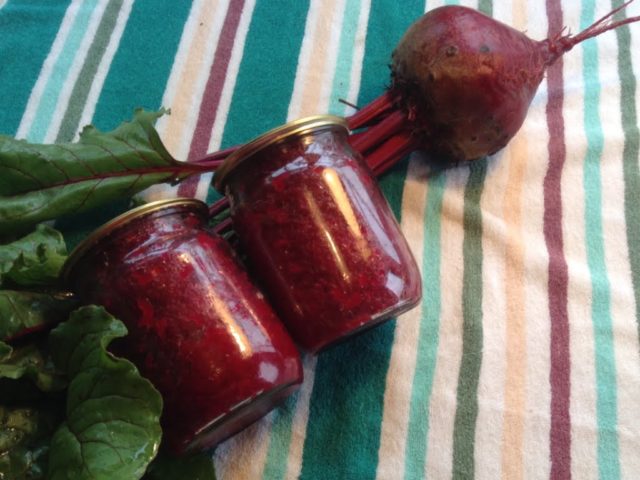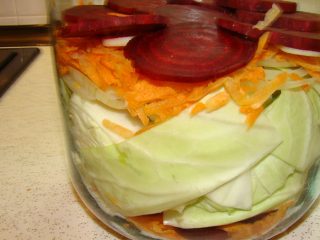Content
- 1 How to salt beets at home
- 2 Beetroot salting recipe without vinegar
- 3 Salting beets for the winter in brine and without it
- 4 How to salt beets for the winter in jars
- 5 How to salt beets with garlic for the winter
- 6 How to salt beets quickly
- 7 A simple recipe for salted beets for the winter
- 8 How to salt boiled beets for the winter
- 9 How to salt beets with plums for the winter
- 10 Storage rules for salted beets
- 11 Conclusion
If the hostess is faced with the question of how to preserve a large amount of beets due to the lack of a cellar, then blanks are better than salted beets for the winter. In the old days, salting vegetables was very popular, since it not only allowed them to preserve useful substances in them, but even increase them. From those times, only the tradition of pickling or pickling cabbage for the winter has been preserved. But salted beets are equally beneficial and tasty.
How to salt beets at home
Surprisingly, quite a lot of various methods and recipes for salting beets for the winter have been preserved. It can be salted fresh and boiled, whole or cut into pieces, with or without sterilization, neat and with the addition of various spices and vegetables.
Any varieties of beets are suitable for salting, but the best result is obtained if you use later varieties. They accumulate the maximum amount of sugar in their pulp (up to 12%).
The size of the root crops also does not really matter, since if desired, they can be cut into halves, or even into several parts.
For salting, you can use any dish, except for aluminum and iron without a protective coating. For small portions in a city apartment, glass jars are ideal. In the conditions of a village or country house, salting can be done in barrels - wooden or more common now plastic.
The preparation of root crops for salting consists in thoroughly rinsing them and cleaning them from contamination. For these purposes, you can even use a stiff brush.
Peeling beets is not always necessary - each recipe contains specific instructions on this matter.
If root vegetables need to be boiled before salting according to the recipe, then they are only thoroughly cleaned of contamination, without cutting off either tails or roots. And as a whole, they put it in a cooking pot. To get the best flavor and color from your boiled vegetable, there are some tips to keep in mind:
- the water in which the beets are boiled is not salted;
- prepared root vegetables are placed in boiling water and immediately covered with a lid;
- the fire when cooking a vegetable should be medium, not strong, and not weak;
- immediately after boiling, the beets are poured with cold water and allowed to cool in this form.
The boiling time depends on the size of the root crops and can vary from 40 minutes to 1.5 hours. Beets are usually baked for an hour.
Beetroot salting recipe without vinegar
According to all the old recipes, vinegar was never used for salting or fermenting vegetables. Salted beetroot itself is a universal product for use (in the form of an independent snack, an addition to first courses, to salads, vinaigrettes). The brine obtained during its manufacture can be used as an independent drink, reminiscent of kvass. Especially if you add a little sugar to it.
And to make salted beets, you need very little:
- about 8 kg of root crops;
- 10 liters of water;
- 300-400 g of salt.
According to this recipe for salting, it is necessary to prepare any large vessel with a wide neck: a barrel, a saucepan or an enamel bucket.
- Root crops of small and medium sizes can be salted whole, the largest are cut into two or four parts.
- The vegetable is washed very carefully, the peel is not peeled, but the longest tails and roots are carefully cut off.
- Prepared vegetables are packed tightly in a clean and dry container.
- To prepare the brine, the salt is completely dissolved in still warm boiled water.
- Allow the brine to cool to room temperature and pour the laid root vegetables into it.
- Next, you need to put a wooden circle on top or a lid of a slightly smaller diameter than the container itself. A load is placed on it (a container with water, stone, brick).
- Vegetables should be covered with brine at least 4-5 cm.
- From above, the container is covered with gauze to prevent midges and other debris from getting into the brine.
- Leave the container with the future salted workpiece in the room at normal temperature for 10-15 days.
- At the beginning of the fermentation process, foam will begin to appear on the surface of the brine, which must be removed every day.
- In addition, if the container is filled to capacity, then during fermentation, part of the brine may be poured out, and this moment must also be provided for.
- After the due date, the container with salted beets is transferred to a cold, but frost-free place: cellar, basement, balcony.
- If there are no suitable conditions for storing salty food in a large container, then you can decompose the contents into jars, fill with brine and store in the refrigerator.
Salting beets for the winter in brine and without it
How beets are salted for the winter in brine was discussed in detail in the previous recipe. But, as with cabbage fermentation, there is an option when salting initially occurs without adding liquid.
According to this recipe you will need:
- 1 kg of beets;
- 1 kg of carrots;
- 300 g onions;
- 25 g of salt.
And additionally for the brine, which will still be needed, but later, you will need:
- 500 ml of water;
- 20-30 g of salt.
Cooking a salty snack:
All vegetables are washed, peeled and chopped with a sharp knife or on a coarse grater.
In a volumetric bowl, mix everything thoroughly, add salt and stir again until the juice starts to release.
Transfer to a suitable fermentation container, place oppression on top and leave in the room for 12 hours.
The next day, the resulting juice is drained, water and salt are added to it and heated to a boil.
After the salt dissolves, the brine is cooled slightly (to about + 70 ° C) and vegetables are poured over it.
The load is placed on top again, covered with a lid, and removed to a cold place with a temperature not higher than + 3-5 ° C.
How to salt beets for the winter in jars
For city dwellers, the recipe for salting beets for the winter in ordinary glass jars will probably be more interesting.
To do this, prescription will require:
- 1 kg of beets;
- 2 pieces of onions;
- 1 tbsp. l. coriander seeds;
- 1 tbsp. l. caraway
- 750 ml of water;
- 15-20 g of salt.
Preparation:
- Beets are washed, peeled and cut in a convenient way: slices, circles, sticks, cubes.
- Peel and cut the onion into thin slices.
- The salt is diluted in water, boiled for several minutes and cooled.
- Banks are sterilized in boiling water, in an oven or microwave.
- Sterile jars are filled with root vegetables, onions, sprinkled with spices and filled with cooled brine so that its level is 2 cm below the edge of the jar.
- Close with plastic lids scalded with boiling water and keep at room temperature for a week.
- Then move to a cool place for 5 weeks, after which the salted beets can be considered ready.
How to salt beets with garlic for the winter
Another interesting salting recipe, according to which the dish turns out to be spicy and spicy and will serve as an excellent and healthy snack, no worse than pickled cucumbers.
You will need:
- 500 g of beets;
- 5 cloves of garlic;
- 2 liters of water (for both cooking and brine);
- 1.5 tbsp. l. salt;
- 10 g parsley;
- 1 bunch of dill;
- 50 g sugar;
- 20 g bay leaves;
- 1 tbsp.l. sunflower oil;
- 3-5 peas of black pepper.
According to this recipe, it is better to choose small root vegetables for salting.
Preparation:
- Rinse the beets thoroughly and put them in boiling water (1 liter) for 10 minutes without removing either the peel or the tails.
- Then immediately place in cold water to cool.
- After the vegetable has cooled, remove the peel from it and cut off the tails on both sides.
- Prepare a brine from the second liter of water by first dissolving salt in it. Then bring the brine to a boil and place finely chopped herbs, chopped garlic and sugar in it.
- Boil for no more than 3 minutes and cool.
- Put peeled, but whole root vegetables and spices in sterile jars.
- Pour with cooled brine, cover and place in a cold place.
How to salt beets quickly
According to this simple recipe, salted beets for the winter in cans can be cooked very quickly. But it is better to store such a blank for the winter in the refrigerator.
For salting you will need:
- 1 kg of beets;
- salt - to taste (from 10 to 30 g);
- 200 g onions;
- 200 ml of vegetable oil;
- bay leaf to taste.
Preparation:
The beets are washed and immersed in boiling water for 15 minutes.
- Cooled in cold water and peeled from the peel and tails with roots.
- Cut into cubes or rings.
- Peel and cut the onion into rings.
- In a prepared sterile jar, chopped onions are placed on the bottom, then bay leaves.
- Stir the chopped beets in a separate container thoroughly with salt, let stand for a few minutes.
- Then spread the top layer in a jar.
- Pour in vegetable oil and shake slightly.
- Cover the neck with parchment paper, secure with an elastic band and place in the refrigerator.
You can enjoy a salty snack in a day.
A simple recipe for salted beets for the winter
Beets salted according to this recipe are as natural as possible, since there is nothing superfluous in the components. But on the other hand, due to sterilization, it can be stored in the winter even in room conditions.
You will need:
- about 1 kg of beets;
- 1 liter of water;
- 20g salt.
Preparation:
- The washed and peeled vegetable is blanched in a standard way in boiling water for about 15-20 minutes.
- Cooled, cut in a way convenient for the hostess and placed in clean jars.
- A brine is boiled from water and salt, hot beets are poured into them in jars.Important! In quantitative terms, the vegetable in relation to the brine should be 60 to 40.
- Banks are covered with lids and sterilized: 40 minutes - 0.5 liters, 50 minutes - 1 liter.
- Roll up hermetically with lids and turn over to cool.
How to salt boiled beets for the winter
From salted beets prepared according to this recipe, especially delicious vinaigrette is obtained, and it is ideal as a dressing for first courses.
You will need:
- 2 kg of beets;
- 1 liter of water;
- 20-25 g of salt.
Preparation:
- Thoroughly washed beets are placed whole in boiling water and cooked until tender.
- Chilled, peeled and peeled, and cut into quarters.
- Salt is dissolved in water, heating it to a boil and boiling for several minutes.
- Pieces of boiled beets are placed in sterile jars, poured with boiling brine and immediately hermetically sealed for the winter.
How to salt beets with plums for the winter
Interestingly, using the same technology, beets with plums are salted for the winter. It turns out a very original in taste preparation, by which real gourmets will not be able to pass by.
To make it you will need:
- 2 kg of small size root crops;
- 1 kg of solid sour plums;
- 3 liters of water;
- 20-30 g of salt;
- 100 g sugar;
- 3-4 carnation buds;
- ½ tsp cinnamon.
For making according to this recipe, boiled beets are used, cut into pieces and blanched for 2-3 minutes in boiling plum water.
The rest of the cooking method is standard.
- Beets and plums are placed in sterile jars in layers, sprinkled with spices.
- Prepare a brine from salt and sugar with water.
- Fruits and vegetables laid in jars are poured with boiling brine and immediately tightened hermetically with lids.
- Store salted beets with plums in a cool place.
Storage rules for salted beets
Salted beets, made in sterilized cans or sealed with sealed lids, can be stored in any cool place without light. Common salted beets require storage in the cold, at a temperature not exceeding + 4 ° C. If such conditions cannot be created, then it is recommended, after the end of the fermentation process, to decompose the workpiece into cans, pour brine and sterilize: 0.5 l cans - at least 40-45 minutes, 1 liter cans - at least 50-55 minutes.
Conclusion
Salted beets for the winter are unique in taste and usefulness and are very easy to harvest for the winter. Any novice hostess can handle it, and its taste can amaze even sophisticated gourmets.
















